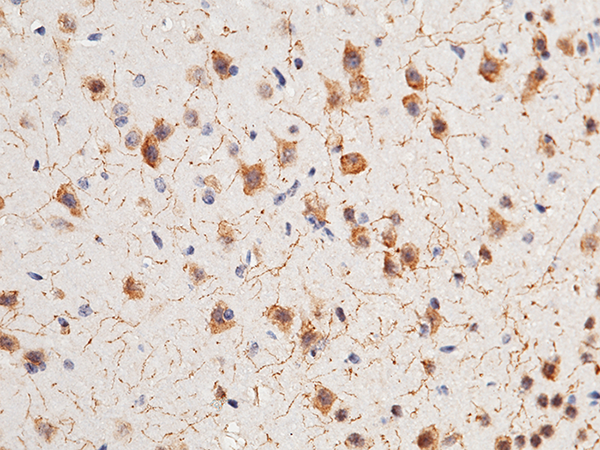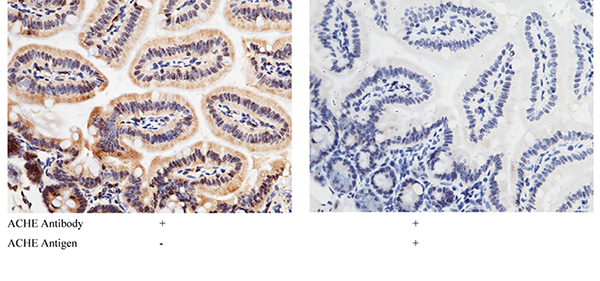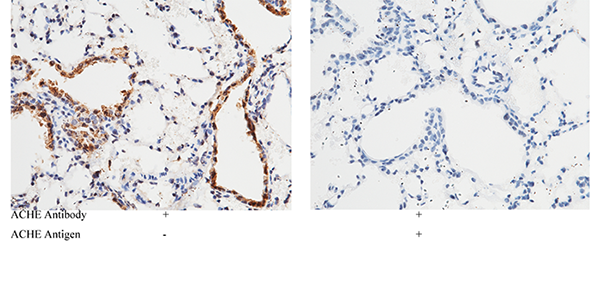-
Product Name
Anti-Acetylcholinesterase antibody
- Documents
-
Description
Rabbit polyclonal to Acetylcholinesterase
-
Tested applications
ELISA, IHC-P
-
Species reactivity
Mouse Acetylcholinesterase / ACHE
-
Alternative names
YT antibody; ACEE antibody; ARACHE antibody; N-ACHE antibody; Acetylcholinesterase antibody; Acetylcholinesterase antibody; ACHE antibody; Ache antibody; ARACHE antibody; mE1a antibody; mE1b antibody; mE1c antibody; mE1c-long antibody; mE1d antibody; mE1d' antibody; mE1e antibody; N-ACHE antibody; YT antibody
- Immunogen
-
Isotype
Rabbit IgG
-
Preparation
Produced in rabbits immunized with purified, recombinant Mouse Acetylcholinesterase / ACHE (rM Acetylcholinesterase / ACHE; NP_033729.1; Met 1-Leu 614). Acetylcholinesterase / ACHE specific IgG was purified by Mouse Acetylcholinesterase / ACHE affinity chromatography.
-
Clonality
Polyclonal
-
Formulation
0.2 μm filtered solution in PBS with 5% trehalose
-
Storage instructions
This antibody can be stored at 2℃-8℃ for one month without detectable loss of activity. Antibody products are stable for twelve months from date of receipt when stored at -20℃ to -80℃. Preservative-Free.
Sodium azide is recommended to avoid contamination (final concentration 0.05%-0.1%). It is toxic to cells and should be disposed of properly. Avoid repeated freeze-thaw cycles. -
Applications
ELISA: 0.1-0.2 μg/mL
This antibody can be used at 0.1-0.2 μg/mL with the appropriate secondary reagents to detect Mouse ACHE. The detection limit for Mouse ACHE is approximately 0.00975 ng/well.
IHC-P: 0.1-2 μg/mL
-
Validations

Acetylcholinesterase / ACHE Antibody, Rabbit PAb, Antigen Affinity Purified, Immunohistochemistry
Immunochemical staining of mouse ACHE in mouse brain with rabbit polyclonal antibody (1 µg/mL, formalin-fixed paraffin embedded sections).

Acetylcholinesterase / ACHE Antibody, Rabbit PAb, Antigen Affinity Purified, Immunohistochemistry
Immunochemical staining of mouse ACHE in mouse intestine with rabbit polyclonal antibody (1 µg/mL, formalin-fixed paraffin embedded sections). The left panel: tissue incubated with primary antibody; The right panel: tissue incubated with the mixture of primary antibody and antigen (recombinant protein).

Acetylcholinesterase / ACHE Antibody, Rabbit PAb, Antigen Affinity Purified, Immunohistochemistry
Immunochemical staining of mouse ACHE in mouse lung with rabbit polyclonal antibody (1 µg/mL, formalin-fixed paraffin embedded sections). The left panel: tissue incubated with primary antibody; The right panel: tissue incubated with the mixture of primary antibody and antigen (recombinant protein).
-
Background
Acetylcholinesterase, also known as ACHE, is an enzyme that degrades (through its hydrolytic activity) the neurotransmitter acetylcholine, producing choline and an acetate group. Acetylcholinesterase plays a crucial role in nerve impulse transmission at cholinergic synapses by rapid hydrolysis of the neurotransmitter acetylcholine (ACh). ACHE appears to be a potential therapeutic target at muscle injuries including organophosphate myopathy. It is an externally oriented membrane-bound enzyme and its main physiological role is termination of chemical transmission at cholinergic synapses and secretory organs by rapid hydrolysis of the neurotransmitter acetylcholine (ACh). ACHE plays important roles in the cholinergic system, and its dysregulation is involved in a variety of human diseases. ACHE was significantly down-regulated in the cancerous tissues of 69.2% of hepatocellular carcinoma (HCC) patients, and the low ACHE expression in HCC was correlated with tumor aggressiveness, an elevated risk of postoperative recurrence, and a low survival rate. Both the recombinant ACHE protein and the enhanced expression of ACHE significantly inhibited HCC cell growth in vitro and tumorigenicity in vivo. ACHE as a tumor growth suppressor in regulating cell proliferation, the relevant signaling pathways, and the drug sensitivity of HCC cells. Thus, ACHE is a promising independent prognostic predictor for HCC recurrence and the survival of HCC patients. ACHE is responsible for the hydrolysis of acetylcholine in the nervous system. It is inhibited by organophosphate and carbamate pesticides. However, this enzyme is only slightly inhibited by organophosphorothionates.
-
References
- Zhao Y, et al. (2011) Acetylcholinesterase, a key prognostic predictor for hepatocellular carcinoma, suppresses cell growth and induces chemosensitization. Hepatology. 53(2): 493-503.
- Roepcke CB, et al. (2010) Analysis of phosphorothionate pesticides using a chloroperoxidase pretreatment and acetylcholinesterase biosensor detection. J Agric Food Chem. 58(15): 8748-56.
- Zaheer-ul-Haq, et al. (2010) Benchmarking docking and scoring protocol for the identification of potential acetylcholinesterase inhibitors. J Mol Graph Model. 28(8): 870-82.
- Pegan K, et al. (2010) Acetylcholinesterase is involved in apoptosis in the precursors of human muscle regeneration. Chem Biol Interact. 187(1-3): 96-100.
Related Products / Services
Please note: All products are "FOR RESEARCH USE ONLY AND ARE NOT INTENDED FOR DIAGNOSTIC OR THERAPEUTIC USE"
